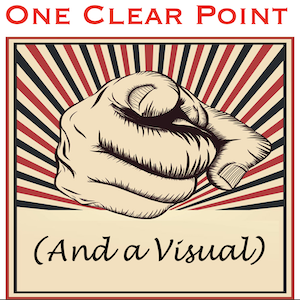By Dr. Ken Broda Bahm

In any challenging communication situation, it is best to combine the visual with the verbal. This is good practice because pictures tend to make things more “truthy,” in the sense that claims that are accompanied by relevant images are more likely to be considered true, even when logically the picture has no probative value. For a trial lawyer, I believe that pictures also work because they put jurors in a more attentive frame of mind: The “dual tracking” that comes from listening while also looking leads to greater engagement. For these reasons, the slide deck is considered by most to be essential. And within PowerPoint and Keynote, the common wisdom and practice is that effective slides come from joining a single point to a single visual reinforcement.
Due to the generally high level of information in court, however, this common advice can be harder to apply for lawyers. After all, if you’re talking about your client’s goals, you can’t just pair that with a picture of a mouse next to a block of cheese. The challenge in being meaningfully visual can cause some attorneys to fall back on their old habits and just put the text into the presentation — the “Here are my speaking notes, but they’re on the screen” approach. That is not the best way to go. It might be easier for the attorney to just present what is written on the slides, but by inducing jurors to both listen and read at the same time, you might make their attention more spotty. In this post, I will share six tips for making your courtroom slides less reliant on text and more focused on meaningful visual reinforcements.
1. Start With Your Process
Don’t start by creating slides and then thinking of what to say for each. Instead, start with what you want to say, and then create a sequence of slides that follows each point. At the start, many of those slides will probably be blank, identified only by their purpose. As you continue to work, you fill in the visuals, perhaps combining or breaking apart slides as you go. Begin with your goals, in sequence. Then, make them visual.
2. For Each Slide, Include a Single Simple “Something-to-Look-At”
You want a central visual focus on each slide. That doesn’t mean a stock photo. The best images will be drawn from the demonstrative and evidentiary focus of your case. And while I say, “image,” that doesn’t necessarily mean a drawing or a photograph. The visual focus can also be a line of text or a call-out from a document. But, the rule is, one at a time. Don’t use a single slide to do 10 call-outs. Each one should get its own slide, with the top-bar label clearly emphasizing what jurors should conclude.
3. Stick to “One Idea Per Slide”
Adding more slides is free, so keep it moving. Don’t make 10 points on a single slide; use ten slides. Your audience will be more focused on the point you’re making if that point is the only thing that is on the screen. The audience also craves new information, so keep providing that — at least one slide per minute is good, more is better. The only exception to the “one idea per slide” rule is when the list is the point: For example, you want the audience to remember three reasons to doubt the other slide. But after you’ve previewed that list, you’ll probably want to flesh it out in three slides, one per reason.
4. Reduce Your Labels to a Few Words
The more your audience is reading, the fewer cognitive resources they will have for listening. To keep them engaged on both the visual and verbal levels, reduce the number of words on any given slide. Labels should be short. If the labels stretch to more than one line in a reasonably big font (30 pt. or more), then they are too long. Often in litigation, the language is the point – so when calling out documents or quoting testimony, obviously those words are critical and can’t be cut down. But when you add a label to that, make it pithy.
5. Don’t Rely on the Screen
The biggest mistake presenters generally make is to rely on the screen as speaking notes. Don’t ever put something on the screen just so it will tell you what to say. There are better ways to do that: memory, practice, or the “notes” field in the presentation. When you’re putting something on the slide, it should always be for the reason of reinforcing your verbal message, not cueing it up.
6. Don’t be Afraid to Use Blank Slides
While the visuals are important, good presenters also know that there are times when you don’t want the audience’s attention to be divided at all by looking at something. For example, if all of our attention ought to be on listening to the 911 call, then perhaps the screen should be blank. There might also be key moments where you want your own words to be the only stimulus — introductions and conclusions, for example. So, while you generally want to make sure that your target audience is both verbally and visually engaged, there may be times to either use a single black slide, or press the “B” key to momentarily black out the screen.
______
Other Posts on Courtroom Visuals:
- Adapt to Evolving Attention
- Witnesses, Add to Your ‘Truthiness’ by Showing Pictures
- Be Multi-Modal in Your Courtroom Visuals
Image Credit: 123rf.com, used under license, edited by author